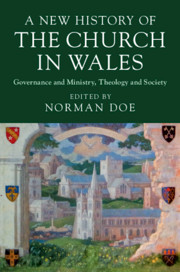Book contents
- Reviews
- A New History of the Church in Wales
- A New History of the Church in Wales
- Copyright page
- Contents
- Plates
- Contributors
- Foreword
- Editorial Preface
- Introduction
- Part I Historical Antecedents and Overview of the Century
- Part II Governance and Ministry
- Part III Doctrine, Liturgy, Rites and Other Faith Communities
- Part IV The Church and Society
- 13 Welsh Anglicans and Cultural Debate
- 14 The Church and Education
- 15 The Church and the Welsh Language
- 16 The Church, State and Society
- Part V Conclusions
- Bibliography
- Index
- Plate Section (PDF Only)
16 - The Church, State and Society
from Part IV - The Church and Society
Published online by Cambridge University Press: 22 February 2020
- Reviews
- A New History of the Church in Wales
- A New History of the Church in Wales
- Copyright page
- Contents
- Plates
- Contributors
- Foreword
- Editorial Preface
- Introduction
- Part I Historical Antecedents and Overview of the Century
- Part II Governance and Ministry
- Part III Doctrine, Liturgy, Rites and Other Faith Communities
- Part IV The Church and Society
- 13 Welsh Anglicans and Cultural Debate
- 14 The Church and Education
- 15 The Church and the Welsh Language
- 16 The Church, State and Society
- Part V Conclusions
- Bibliography
- Index
- Plate Section (PDF Only)
Summary
The relationship between the Church in Wales and the state and society after 1920 grew out of a heritage of engagement long pre-dating disestablishment. While the Church in Wales adapted quietly to its new status, its relations with civic society continued as before, mediated by the continuance of the social provision of the dioceses. Dioceses like St. David’s, through their Organising Secretaries and Outdoor Workers, made a considerable contribution to the development of social work and probation services from the 1930s to the late 1960s. Undergirded by provincial financial support, in the 1980s and 1990s, dioceses developed partnerships with local authorities, government schemes, and the Children’s Society. However, while engagement with social needs has been robust at diocesan level, the Church in Wales took some time before finding a provincial voice. Governing Body debates became more outward-looking in the run-up to the Millennium, but the impetus is waning. From the mid 1980s, provincial bodies, like the Board of Social Responsibility, developed a provincial forum not only to discuss societal issues but a means by which dioceses could work together. Reaching a peak in the late 1990s, this way of working has been declining since.
- Type
- Chapter
- Information
- A New History of the Church in WalesGovernance and Ministry, Theology and Society, pp. 293 - 312Publisher: Cambridge University PressPrint publication year: 2020

